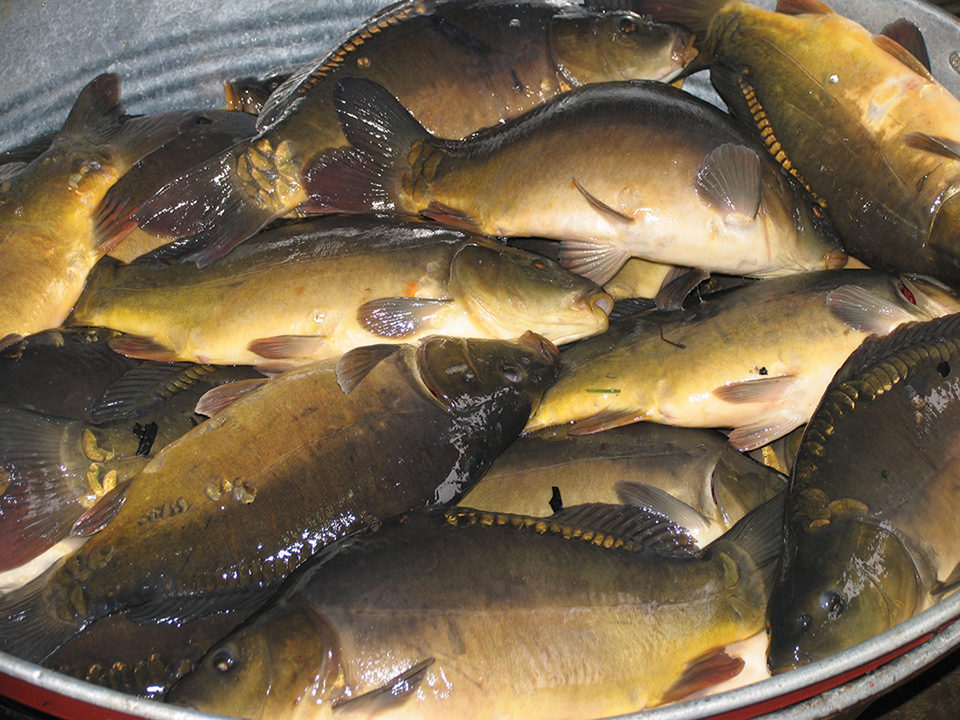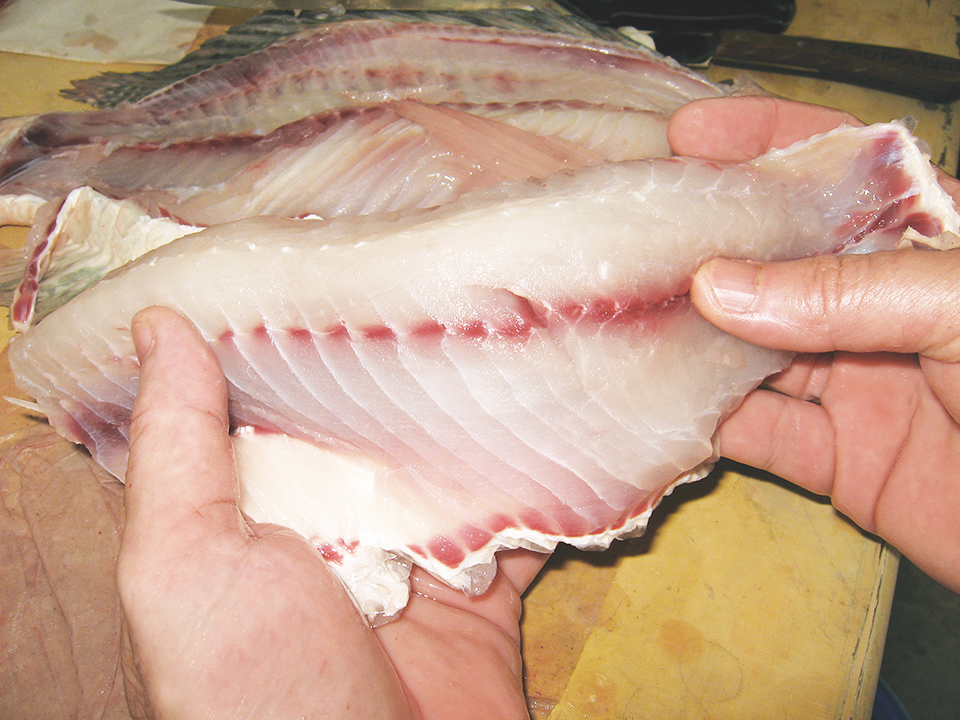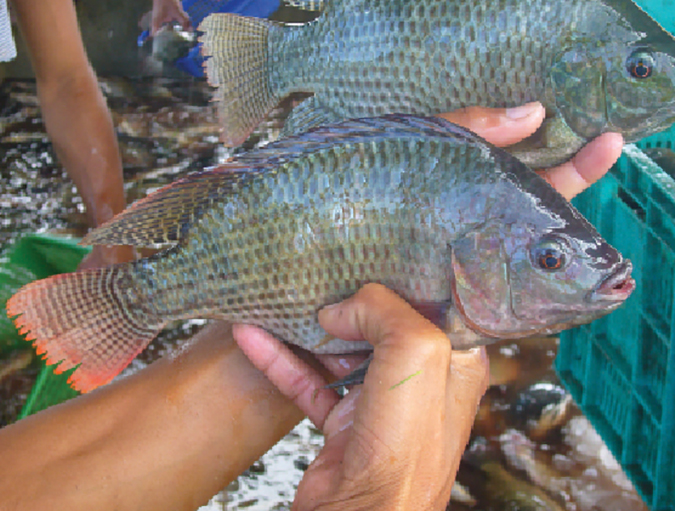Activities in cultured species

Decomposition of fresh fish and shellfish is primarily due to exogenous microbiological contamination from processing and marketing. However, endogenous decomposition through catheptic enzyme activity post-mortem can also be a contributing cause for quality loss and spoilage.
Pre-slaughter stress, especially long-term stress, has been shown to increase cathepsin gene expression and cathepsin activity, resulting in texture loss, low fillet yield and decreased water-holding capacity. Proteolytic activity by catheptic enzymes varies with species and individual enzyme.
Atlantic salmon
In studies, Atlantic salmon, salmo salar, were subjected to 20-minute short-term and 24-hour long-term pre-slaughter crowding stresses. The significant negative effects seen were mostly due to long-term stress at early stages post-mortem, but short-term stress also had significant impacts on the muscle quality of pre- and post-rigor fillets.
Pre-slaughter long-term stress lowered muscle pH, softened the fillets and increased muscle cathepsin L gene expression immediately post-mortem. A tendency for increased cathepsin B gene expression and total cathepsin B activity was also noted. Stress further accelerated the influence of myofiber-myofiber detachments, increasing the percentage of myofiber-myocommata detachments over storage time.
Significant correlations were observed among muscle pH and cathepsin B + L activity, muscle texture and muscle degradation parameters. Cathepsin B activity was correlated with muscle degradation, and cathepsin L gene expression related to muscle degradation and texture.
Pre-slaughter stress, especially long-term stress, accelerated cathepsin activity, resulting in faster muscle degradation, directly or indirectly connected to the low initial muscle pH. Research produced similar results in seabass, Dicentrarchus labrax L., where cathepsin B and L activities were found in more important amounts in the white muscle. On the other hand, cathepsin D activity was 1.4 times higher in meat than in fish muscle, while cathepsin H was negligible in both muscles.
Carp
Cyprinus carpio and Hypophthalmichthys molitrix carp have been used to produce surimi, since fillet production with the species can cause meat waste due to the high amount of fish bone in the edible portion of the fish.
Myofibrillar components, especially myosin heavy chain, are essential for surimi gel formation. However, when the surimi passes through the temperature zone of 40 to 60 degrees-C to form a gel, its protein components can be degraded, eventually causing very low gel strength.
Many researchers have demonstrated that this degradation is caused by endogenous proteases in fish muscle, especially serine- and cyteine-type proteases. Cathepsins L and B, both cysteine proteases, can hydrolyze a broad range of proteins, such as myosin, actin, nebulin, myoglobin, hemoglobin and insoluble collagen.
When cathepsin L enzyme activity was not inhibited, the gel strength significantly decreased by 24.3 percent compared to the control. However, the gel strength of surimi with an enzymatic inhibitor increased by 13.7 percent. Both the sodium dodecylsulphate polyacrylamide gel electrophoresis electrophoretic pattern and microstructure figures revealed that cathepsin L could hydrolyze the main protein in carp surimi and was one of the enzymes involved in the modori phenomenon, a process where very low gel strength causes surimi gel disintegration.
Studies have shown that carp actomyosin is affected by L-, H-, and B-like cathepsins (Table 1). Subsequent studies have indicated there are at least two kinds of cathepsin B enzymes in carp.
Flick, Activities of tested enzymes, Table 1
| Activity in Actomyosin (x 10-6 unit/mg protein) L-like | Activity in Actomyosin (x 10-6 unit/mg protein) H-like | Activity in Actomyosin (x 10-6 unit/mg protein) B-like |
|
|---|---|---|---|
| Carp | 26.47 | 5.47 | 5.17 |
Rainbow trout
Post-mortem softening of trout and other fish species often results in low yield and decreased product quality. In research, extracts of rainbow trout (Oncorhynchus mykiss) stored five days were incubated with cathepsins B, L and D, alone and in combination, to evaluate the effects on texture-related proteins.
Cathepsins D, B and L affected, respectively, 10, nine and four of the 17 protein bands associated with firmness. Most changes induced by cathepsin D were unfavorable to firmness. This implied that cathepsin D is likely involved in the textural change of trout due to muscle structure decomposition.
It is also possible the proteolysis could occur in temperatures between 15 and 55 degrees-C, and also be active during some cooking processes. It has been noted that the amino acid sequence of carp cathepsin B is similar to 80 percent of that in rainbow trout.
Seabass
Studies have found that cathepsins B, D and L degraded myosin heavy chain and α-actinin in seabass. Tropomyosin and actin were only susceptible to the action of cathepsin L. Troponin T was resistant only to the action of cathepsin D. Desmin, a major intermediate filament protein essential for the structural integrity and function of muscle, was degraded by cathepsins B and L.
Slight changes of some other myofibrillar or cytosolic proteins were also observed. When compared with protein modifications observed in stored post-mortem muscle, these results suggested that cathepsin D could be involved in a post-rigor myofibrillar degradation mechanism.
Shrimp
Only limited information has been published on cathepsins in shrimp. However, cathepsin D obtained from banded shrimp, Penaeus japonicas, and grass or black tiger shrimp (Penaeus monodon) had optimal temperatures at 50 and 45 degrees-C. The thermostability of the cathepsin D from black tiger shrimp was higher than that from banded shrimp. Although both cathepsins had similar optimal pH values near 3, banded shrimp had broader pH stability than the black tigers.
(Editor’s Note: This article was originally published in the July/August 2014 print edition of the Global Aquaculture Advocate.)
Now that you've reached the end of the article ...
… please consider supporting GSA’s mission to advance responsible seafood practices through education, advocacy and third-party assurances. The Advocate aims to document the evolution of responsible seafood practices and share the expansive knowledge of our vast network of contributors.
By becoming a Global Seafood Alliance member, you’re ensuring that all of the pre-competitive work we do through member benefits, resources and events can continue. Individual membership costs just $50 a year.
Not a GSA member? Join us.
Authors
-

George J. Flick, Jr., Ph.D.
University Distinguished Professor
Food Science and
Technology Department
Center for Applied Health Sciences
Duck Pond Drive
Virginia Tech (0418)
Blacksburg, Virginia 24061 USA[117,100,101,46,116,118,64,103,107,99,105,108,102]
-

David D. Kuhn, Ph.D.
Assistant Professor
Food Science and
Technology Department
Center for Applied Health Sciences
Duck Pond Drive
Virginia Tech (0418)
Blacksburg, Virginia 24061 USA[117,100,101,46,116,118,64,110,104,117,107,101,118,97,100]
Tagged With
Related Posts

Health & Welfare
Cathepsin enzymes, part 1
Cathepsins B, D and L are considered critical in fish muscle post-mortem modifications or gel softening during the setting of surimi.

Aquafeeds
A look at protease enzymes in crustacean nutrition
Food digestion involves digestive enzymes to break down polymeric macromolecules and facilitate nutrient absorption. Enzyme supplementation in aquafeeds is a major alternative to improve feed quality and nutrient digestibility, gut health, compensate digestive enzymes when needed, and may also improve immune responses.

Aquafeeds
A look at phospholipids in aquafeeds
Phospholipids are the major constituents of cell membranes and are vital to the normal function of every cell and organ. The inclusion of phospholipids in aquafeeds ensures increased growth, better survival and stress resistance, and prevention of skeletal deformities of larval and juvenile stages of fish and shellfish species.

Health & Welfare
Dietary acidification in aquaculture
Much of the chemical breakdown of foodstuffs begins in the stomachs of animals through acidification. Effective use of digestive biology is a goal in aquaculture, so dietary acidifiers have been gaining interest in recent years.


